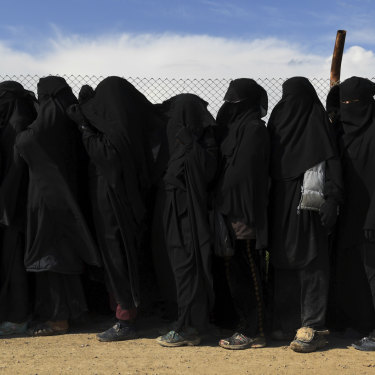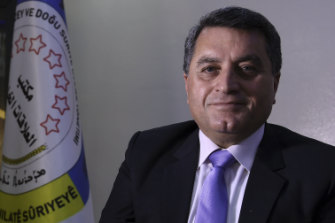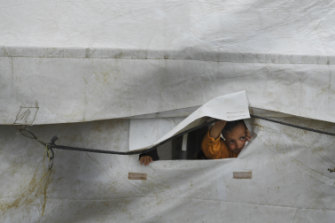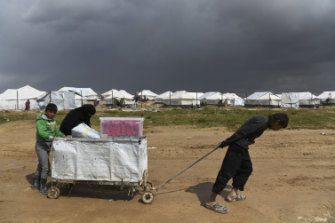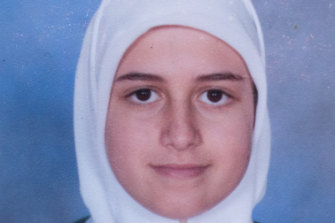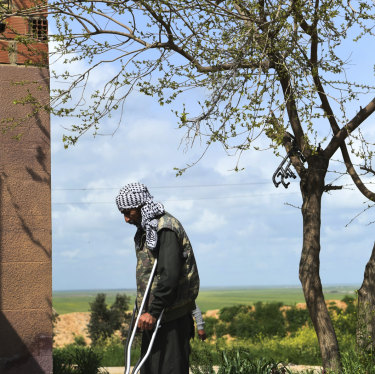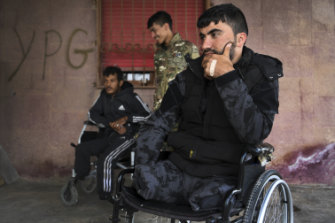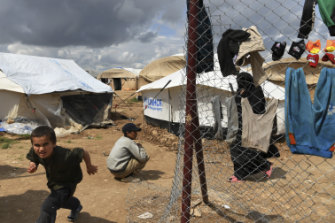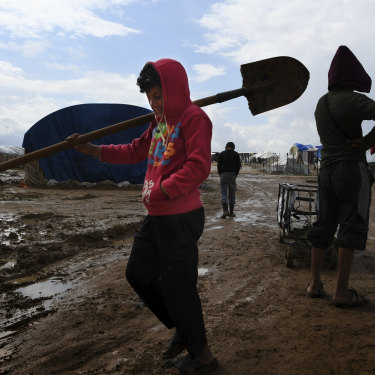Home » World News »
The bitter legacy of Islamic State
Qamishli, Syria: The small Australian enclave in al-Hawl camp in northern Syria lies on the edge of a giant sea of white-and-blue refugee tents.
This is a city without infrastructure, where 73,000 women and children from all around the world – Russia and the Caucasus, South-east Asia, the Middle East, Africa – are sheltering after the collapse of the so-called Islamic State.
It is a rough place. Guards have fired warning shots in the air in recent days because of growing tensions. Many of the 4000 women who were aligned with IS remain wedded to their hardline vision of Islam and have been brutalising others. Without exception, women in the camp wear the Saudi-style full black dress and niqab face covering. A woman from Trinidad told a visiting journalist this week she had been beaten up for removing hers.
Foreign IS wives and children line up near the foreign section of al-Hawl camp to be taken to the shops.Credit:Kate Geraghty
There have been reports of women murdered and of IS wives acting as the camp’s morality police, bullying in particular women who are there simply as refugees.
It's in these circumstances, in the cluster of tents inhabited by Australians, that young women such as the children of notorious terrorist Khaled Sharrouf are now living. They want to come home, and their wishes are putting the Morrison government in a bind.
This sprawling human mess is one of the legacies of the collapse of the IS "caliphate". In the five years since a small gang of Iraqis who cut their teeth in al-Qaeda’s fight against the US-installed government in Baghdad seized on the chaos of the Syrian civil war to establish a power base there, the caliphate has swelled to territory nearly half the size of Britain and then been ground back down to nothing.
These hellish five years, as well as tearing yet another hole in the Arab world, has left a festering set of problems after the final military and territorial defeat of IS in the small Syrian town of Baghouz in the Euphrates Valley.
As well as the 12,000 women and children who’ve emerged from the darkness of IS rule, there are more than 1000 male foreign fighters and enthusiasts who’ve been captured and placed in Kurdish jails.
The Kurdish administration that is left clutching this tinderbox has uncertain political prospects, with its nemesis Turkey on one side and the hostile Syrian regime of Bashar al-Assad on the other.
It says it needs the burden of IS's human legacy lifted. In its favour it uses the moral argument that its men and women did most of the fighting and dying on the ground.
Pockets of IS resistance remain, meanwhile, around Baghouz, and Kurdish officials talk of “sleeper cells” in Sunni Arab areas, portending a lengthy counter-insurgency comparable to those in Afghanistan and Iraq, for which they will need help from the US and its allies.
This is what happens when you demolish a proto-state based on an apocalyptic ideology that drew violent extremists from around the world.
'We are still at war'
From less gentlemanly lips, Abdul-Karim Omar’s words might come across as a veiled threat. Omar is the Syrian Kurdish administration’s top foreign affairs official and is widely regarded as a decent and straight politician.
“We are still at war. There are threats against this area from Turkey and other sides. Attacks will happen against this area and also disorder, anarchy will happen,” he said this week.
The Kurdish administration in north-east Syria’s foreign affairs spokesman, Dr Abdul-Karim Omar, in his office in Hassaka, northern Syria. Credit:Kate Geraghty
“That will create an opportunity for the Islamic State fighters to be able to escape from the prisons. They will become a danger to us and also will be a danger to the international community.”
The Kurdish administration in north-eastern Syria and its military form the backbone of the Syrian Democratic Forces, which defeated IS on the ground. They have been supported by the international coalition and in particular the US, which has special forces soldiers serving as advisers.
The Kurds want that support to continue, both on the military side but also in the form of reconstruction aid and an international court, established in Kurdish-held territory, to impose justice on captured IS members. They have thrown this up as an alternative to countries taking back their foreign fighters for prosecution – a previous plea that fell on deaf ears, including in Canberra.
They also want countries including Australia to take back the women and children.
“We don’t have any arrangements for returning women and kids. The countries should initiate dialogue with us,” Omar said. “There is nothing we can do on our own because most of the people don’t have any documents. When they contact us, we will organise the permits to send them back and those countries can repatriate the women and kids.”
Unfortunately so far, it’s been every country for itself, aside from a handful of French and Russian orphans that have been repatriated.
The Morrison government’s position is that it won’t risk Australian officials’ safety by sending them to northern Syria to collect people, nor risk Australians at home by bringing back potential terrorists, whom there may not be sufficient evidence to prosecute.
On the outside looking in: a child peeks through the flap of a tent in the foreign section of al-Hawl camp in Syria.Credit:Kate Geraghty
In remarks that are unlikely to reassure Australians, Omar said most of the children over eight years old had been indoctrinated by IS and given military training as so-called “cubs” of the caliphate.
“We are doing our best to encourage the international community to take responsibility,” he said. “If we don’t rehabilitate those kids, they will become time bombs and will go back to their countries as terrorists who carry out attacks.”
The Australians who joined IS or lived in its territory and have spoken to The Sydney Morning Herald and The Age this week in Syria say that not everyone associated with the group is equally culpable.
The sheer barbarity of IS has created a mythology that has clung to it, which the group itself eagerly cultivated by spreading images of mass executions, human heads on spikes, the throwing of gay men from rooftops and the trade in sex slaves drawn from minority groups, as if it were trying to provoke the greatest possible revulsion.
A woman and two boys push a cart near the fence line of the foreign section of al-Hawl camp.Credit:Kate Geraghty
But the gradations of culpability are easily captured by the examples of families such as the Sharroufs or the Assaads.
Khaled Sharrouf was a violent terrorist who allegedly kept young women from Iraq’s Yazidi minority as sex slaves and gave his eldest daughter Zaynab to his friend and fellow terrorist, Mohamed Elomar, for marriage when she was just 13.
Zaynab’s younger sister Hoda Sharrouf, 16, asked this week when interviewed by the Herald and Age why Australians like her, dragged to Syria against their will by their parents, should be abandoned.
She was 11 when her mother Tara Nettleton brought her to Syria, along with her four sisters and brothers, to join their father.
“What about the people that didn’t want to come here?” she said.
A further step removed, Zaynab has two children and a third on the way. Those children are clearly entitled to Australian citizenship and no other. Unless Canberra gives them the opportunity to apply, they will be stateless and stuck in Kurdish Syria.
The case of the Assaad family, meanwhile, is a maze of moral complications. Shayma Assaad was 15 when her father Ahmed and mother Bassama brought her to Syria. The family says they were looking for Shayma’s two brothers who’d joined the caliphate. If this is true, why did the parents bring their 15-year-old daughter with them for a search in a war zone?
“I can’t leave my kids, that’s why,” Bassama said.
Kirsty Rosse-Emile in her school days.Credit:Simon Schluter
This is consistent with other IS women in the camp who’ve spoken to international journalists, though there is considerable scepticism among informed foreign observers about this.
There is a suspicion that some men and women may have been schooled by IS in how to assert their innocence.
Meanwhile, international aid groups monitoring and working in al-Hawl camp are worried about conditions there. Shayma and Kirsty were both critical of the conduct of the Kurdish camp officials and the facilities.
“There’s few toilets. They’re all disgusting. You have to go walking miles and miles to get things done. They don’t let you out, they don’t let you call. It’s like a prison here really,” Kirsty said.
It is not, at least, a mass grave. The United Nations has estimated that as an “absolute minimum”, IS killed 30,000 civilians between 2014 and 2017.
Skilled but utterly unprincipled
At a farm near the town of Hassaka in Syria, Kurdish veterans are healing themselves. If anyone knows the horrors of IS, it is these men. To most of the world, IS has been terrifying but largely abstract.
These men are the heroes who actually fought IS up close. And they describe a skilled but utterly unprincipled enemy.
Syrian Democratic Forces soldier Khalid Mustafa, 43, at a house in Hassaka where militiamen are recuperating from their injuries. Credit:Kate Geraghty
“They are like monsters,” said Sipan Abdulrahman, 37, a Kurdish soldier who lost both of his legs at Baghouz to an IED, the favoured IS weapon that it has arrayed throughout every city, town and village it has held.
“They would put them everywhere,” he said. “They would put a Koran on the floor with a trigger on it. Our fighters would directly go to pick it [the Koran] up.
“We are already Muslim. They didn’t need to convert us.”
Swar Rojdam, 23, lost both his legs and a forearm after being hit by two IEDs in a house in quick succession. He was helping clear the village of Tal Hammam of IS fighters when two men turned up on a motorbike claiming to be locals who just wanted to move back into their house.
Rojdam and a comrade agreed to check the men’s house. As they searched rooms, they set off two time-delayed bombs.
His comrade died. Rojdam never found out whether the men on the motorbike were genuine villagers or IS members playing a ruse.
Syrian Democratic Forces soldier Swar Rojdam, 23, right, with fellow injured soldiers.Credit:Kate Geraghty
The Kurdish forces expect to face years of these tactics. Thanks to the mismatch between sovereign territory and allegiances that has bedevilled the Middle East for a century and been turbocharged by the Syrian civil war, the Kurds now control territory that includes swathes of land inhabited by Sunni Arabs.
Across Deir al-Zor province, through which IS – including the Sharrouf and Assaad families – retreated after being pushed out of the caliphate's de facto capital of Raqqa, there is militant resentment. The villagers there see the Kurds as an occupying force. The Syrian Democratic Forces are still suffering daily attacks.
A week after the declaration of victory against IS on March 23, a local military commander near Baghouz showed the Herald and Age a video of coalition planes and Kurdish tanks still bombarding IS fighters in caves near Baghouz.
Foreign IS wives and children in the overcrowded al-Hawl camp.Credit:Kate Geraghty
Kurdish official Abdul-Karim Omar said the Sunni extremist problem – the foundation of groups from al-Qaeda to IS – won’t be solved as long as the larger structural issues around government remain in Syria, which is why the Kurds desperately want the international community to stay involved.
Australia is not the only country looking askance at its lingering IS problem. Britain has wrestled with its conscience over the case of Shamima Begum, who travelled to Syria as a 15-year-old schoolgirl. She lost her newborn baby in a refugee camp last month while the British government stripped her of her citizenship.
There may be precious little sympathy in Australia for IS fighters and enthusiasts who now want to come home.
But as the caliphate itself fades into history, the most pressing question will become what to do with its legacy of broken human beings.
Children carry tools through the mud at the squalid al-Hawl camp.Credit:Kate Geraghty
Source: Read Full Article
